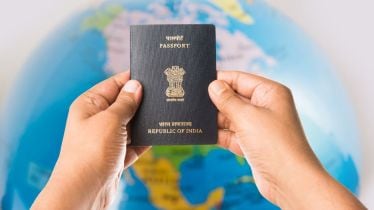Government of India has taken a significant step in modernizing the air travel documentation system with the official rollout of electronic passports, or e-passports. These e-passports have been designed to enhance security, speed up immigration checks, and align with global travel standards. More than these advantages the e-passport represents a technological shift in how Indians will travel abroad in the coming years.
What Is an E-Passport?
An e-passport is very similar to the traditional Indian passport but comes equipped with an embedded electronic chip inside its back cover. This chip securely stores the passport holder’s personal and biometric details that includes various details like fingerprints, facial recognition data, and digital signatures.
Additionally this technology ensures that the information printed on the passport matches the data stored in the chip. Therefore making it nearly impossible to forge or tamper with.
Moreover, e-passports carry a special gold symbol on the cover, making them easily recognizable at airports and border security checkpoints. The chip embedded in the passport allows for quicker scanning and verification, reducing waiting times for travelers.
Who Can Apply for an E-Passport?
Well any Indian citizen who is eligible for a regular passport can now apply for an e-passport. Although, initially, the facility is being offered at some limited Passport Seva Kendras (PSKs) and Post Office Passport Seva Kendras (POPSKs) across India.
Therefore interested applicants should confirm whether their local passport office has started issuing e-passports before applying.
Considering the scale of this process the government plans to gradually expand the service nationwide. This will help in ensuring that both new applicants and those renewing their passports can benefit from the upgrade.
What is the Application Process?
The process of applying for an e-passport follows the same steps which are used in applying for a traditional passport. All applicants must register on the official Passport Seva portal, then fill out the online form, pay the required fee, and schedule an appointment at a Passport Seva Kendra or Post Office Passport Seva Kendra.
During the appointment, biometric data such as fingerprints and photographs will be captured of the person.
Once processed, the e-passport is printed with the embedded chip and sent to the applicant’s registered address.
Benefits and Future Outcomes!
E-passports offer several advantages and a unprecedented level of improved security, faster immigration clearance for travellers, and better global acceptance of the Indian passport.
The most pivotal advantage of the e-passports is that the embedded chip significantly reduces the risk of identity theft or duplication. This helps in making international travel even more safer for Indian citizens.
Lastly as the rollout of the e-passports expands. Individuals should importantly check whether or not there nearest passport office or seva kendras offer this facility.
Since the e-passport marks a transformative move toward a smarter, more secure travel ecosystem for India. Therefore it is paving the way for seamless global mobility of Indian citizens in the digital age.
